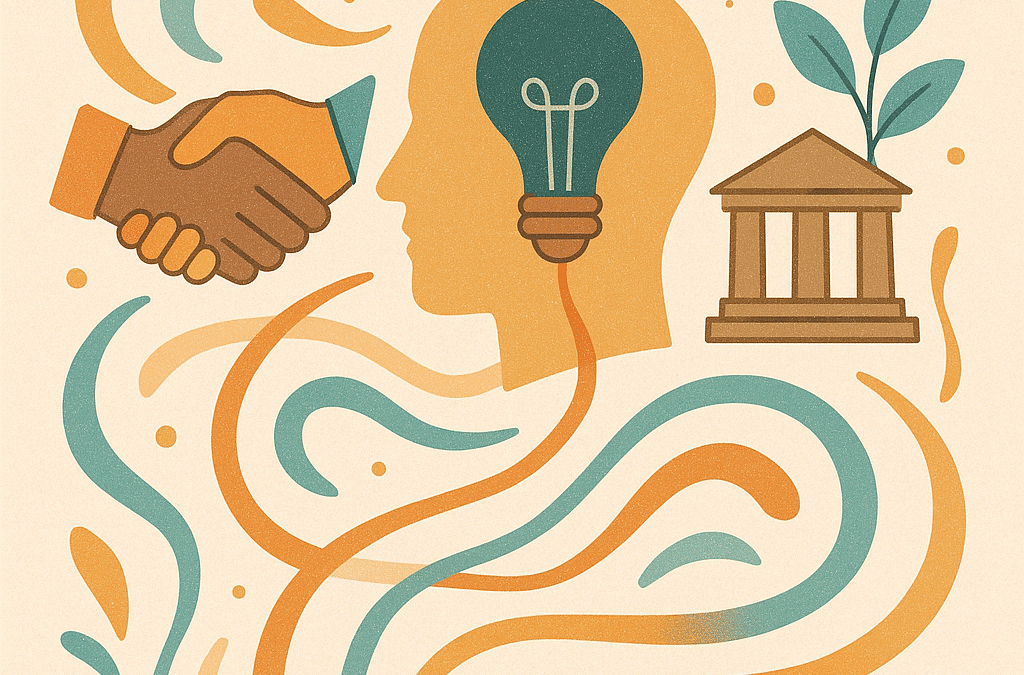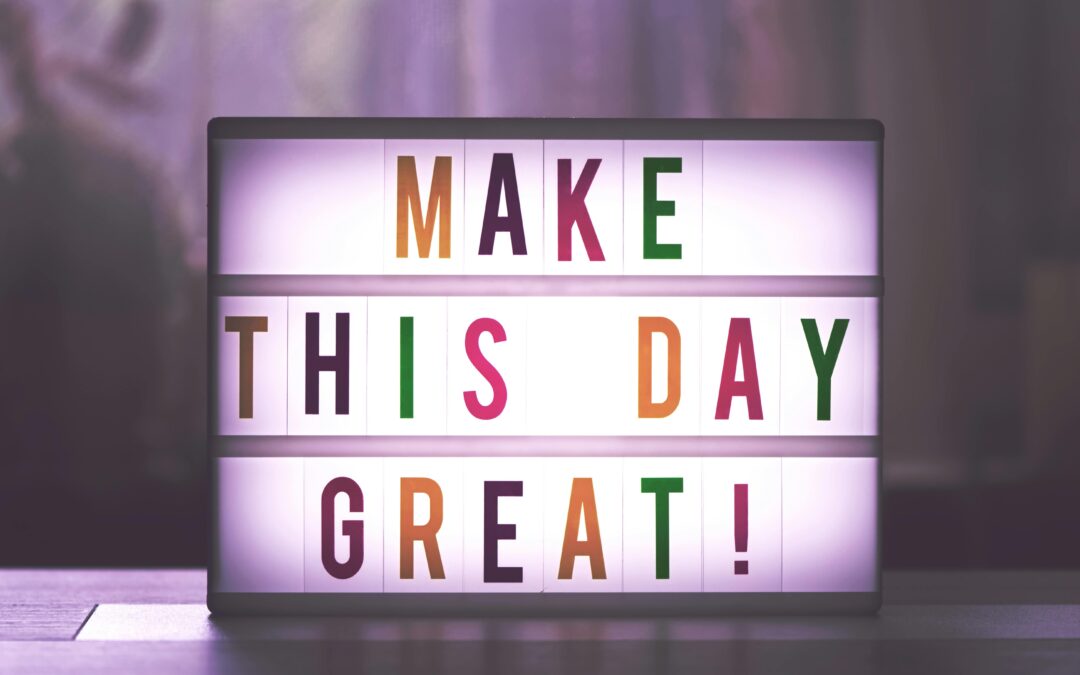
Nov 18, 2025
There’s a familiar tension that settles into workplaces during tight quarters—when budgets shrink, deadlines loom, and every resource feels stretched thin. You can hear it in the language people use: “We don’t have time for that.” “There’s no budget.” “We’re already spread too thin.”
This is scarcity thinking, and while it often feels like realism, it quietly erodes something far more valuable than time or money: trust.
When Scarcity Becomes the Story
A scarcity mindset isn’t just about acknowledging genuine constraints. It’s about operating from a chronic sense of “not enough”—a belief that becomes the default lens through which we view every decision, every request, every possibility.
When scarcity thinking takes root in a team, it creates a cascade of behaviors that undermine collaboration:
People hoard information and resources because sharing feels risky when everything seems scarce. That project insight that could help a colleague? You hold onto it, just in case you need it later.
Innovation stalls because trying something new requires resources—time, attention, budget—that “we simply don’t have.” The safer choice is to keep doing what we’ve always done, even when it’s not working.
Trust deteriorates because scarcity breeds competition rather than collaboration. When team members believe there isn’t enough recognition, opportunity, or support to go around, they start protecting their territory instead of building together.
The irony? Scarcity thinking often creates more scarcity. When we operate from “never enough,” we miss the resources, skills, and possibilities that are already present.
Spotting Scarcity Thinking in Action
Scarcity mindset shows up in predictable patterns. Listen for these phrases in your next meeting:
- “We can’t afford to…” (without exploring what we can afford)
- “There’s no time for…” (without asking what we could make time for)
- “We don’t have the people…” (without considering the skills already on the team)
- “That’s not in the budget…” (as a conversation-ender rather than a starting point)
Watch for behaviors that signal scarcity thinking:
Knee-jerk “no” responses to new ideas before genuinely exploring possibilities
Zero-sum thinking where one person’s gain is automatically framed as another’s loss
Rigid resource guarding where sharing tools, time, or knowledge feels threatening
Chronic crisis mode where urgency prevents any strategic, long-term thinking
These aren’t character flaws. They’re survival responses to feeling perpetually under-resourced. But they become self-fulfilling prophecies that keep teams stuck.
One Question That Shifts Everything
Here’s a simple intervention you can try this week, perhaps at your next team meeting:
Ask: “What’s one resource or skill you feel we have more than enough of?”
This single question does something powerful—it redirects attention from deficit to abundance without denying real constraints.
You might hear:
“We actually have incredible problem-solving skills on this team. When we face a crisis, people show up.”
“We have more creative energy than we give ourselves credit for. The challenge is we don’t create space to use it.”
“We’ve got strong relationships with our customers. That’s a resource we could leverage more intentionally.”
The answers matter less than the reframe. You’re training your team to spot abundance alongside scarcity—not as toxic positivity, but as accurate accounting.
Try This at Your Next Meeting
Here’s how to use this as a practical team intervention:
1. Set the context simply. You might say: “I’ve noticed we often focus on what we’re short on—time, budget, people. That’s real, but I’m curious about the flip side. Let’s spend five minutes on a different question.”
2. Ask the question and pause. “What’s one resource or skill you feel we have more than enough of?” Then stay quiet. Let people think.
3. Capture what you hear without judgment. Write responses where everyone can see them. Don’t debate or qualify. Just acknowledge: “Yes, that’s something we have.”
4. Follow with one more question. “Given what we just named, what becomes possible?” This bridges recognition of abundance to action.
5. Close with a nudge. “This week, I’m going to try noticing one moment where we have ‘enough’ of something—time, goodwill, creativity, whatever. I’m curious what you’ll notice too.”
This isn’t about pretending constraints don’t exist. It’s about refusing to let scarcity be the only story you tell.
From Scarcity to Sufficiency
The shift from scarcity to sufficiency thinking doesn’t require more resources. It requires more accurate seeing.
When teams can acknowledge both constraints and capabilities, something loosens. People start sharing more freely because they’re not clinging so tightly to what they have. They experiment more because they recognize the abundance of creativity and resilience already present. They trust more because they’re not competing for scraps.
Scarcity will always be part of organizational life. Deadlines, budgets, and capacity limits are real. But when scarcity becomes the dominant narrative—when “never enough” shapes every conversation—it limits what teams can see, imagine, and build together.
Your organization already has more than you think. The work is learning to see it.
This week’s invitation: Ask your team that one question. Notice what shifts when you do.

Nov 7, 2025
We’ve all been there. That moment when you feel like there’s just not enough—not enough time, not enough budget, not enough talent, not enough opportunities to go around. It’s a feeling that creeps into our decision-making, our relationships, and especially into the cultures we build at work.
At Lillian Moya & Company, we spend a lot of time thinking about the human side of economics—not just the numbers and spreadsheets, but how our beliefs about resources shape the way we treat each other and build our organizations. And one of the most powerful (and often invisible) forces at play? Scarcity thinking.
What Is Scarcity Thinking?
Scarcity thinking is exactly what it sounds like: a mindset rooted in the belief that there isn’t enough to go around. Not enough success, recognition, opportunities, or resources. When we operate from scarcity, we see the world as a zero-sum game—if you win, I lose. If you get the promotion, that’s one less opportunity for me. If we invest in your project, mine suffers.
It’s a protective instinct, really. Our brains are wired to notice threats and limitations. But here’s the problem: when scarcity thinking becomes the default lens through which we see everything, it doesn’t just affect our decisions—it fundamentally changes how we show up for one another.
The Human Cost of Scarcity
When scarcity thinking takes root in an organization, you start to see it everywhere:
People hoard information instead of sharing it freely, worried that knowledge is power and giving it away means losing their edge.
Collaboration feels risky because if someone else shines, it might dim your own light.
Innovation stalls because trying something new means using resources that feel precious and limited.
Trust erodes because everyone’s operating from a place of self-protection rather than collective possibility.
The irony? Scarcity thinking actually creates the very limitations it fears. When we hold tight to what we have, we cut ourselves off from the generative power of collaboration, creativity, and shared success.
Human Economics: A Different Approach
This is where human economics comes in—the understanding that how we approach one another isn’t separate from organizational success; it is the foundation of it.
Traditional economics focuses on the allocation of scarce resources. But human economics asks a deeper question: What if the most valuable resources—creativity, trust, collaboration, goodwill—actually multiply when shared rather than divide?
When you share knowledge, you don’t have less of it. When you celebrate someone else’s success, it doesn’t diminish your own. When you invest in relationships and create psychological safety, you unlock innovation and resilience that no amount of hoarding could ever produce.
Building Organizations That Thrive
Organizations rooted in abundance thinking—the opposite of scarcity—approach success differently:
They celebrate wins across the board, knowing that success in one area lifts everyone up.
They invest in people, trusting that developing talent creates capacity rather than depleting it.
They share information freely, understanding that transparency builds trust and trust drives performance.
They encourage experimentation, knowing that innovation requires the space to try, fail, and learn.
These aren’t just feel-good principles. They’re strategic advantages. Study after study shows that organizations with high trust, strong cultures of collaboration, and genuine investment in their people outperform their competitors—not in spite of their people-first approach, but because of it.
The Shift Starts With Awareness
Here’s the good news: scarcity thinking isn’t permanent. It’s a habit, and like any habit, it can be changed.
It starts with noticing. When you find yourself thinking “there’s not enough,” pause and ask: Is that actually true? Or is that fear talking?
Then, practice abundance. Share credit. Celebrate others. Invest in relationships. Create space for collaboration. Make decisions from a place of possibility rather than protection.
And if you’re a leader? Your mindset sets the tone for everyone. When you model abundance—when you demonstrate through your actions that success isn’t finite, that there’s room for everyone to thrive—you give permission for your entire organization to do the same.
The Bigger Picture
At Lillian Moya & Company, we believe that the future belongs to organizations that understand this fundamental truth: how we treat each other matters. Not as a side note to the “real work” of business, but as the very foundation of sustainable success.
Human economics isn’t soft. It’s strategic. It’s recognizing that the quality of our relationships, the generosity of our collaboration, and the abundance of our thinking directly impact our ability to innovate, adapt, and thrive.
So the next time you notice scarcity thinking creeping in—whether in yourself or in your organization—remember: there’s another way. A way that’s more human, more generous, and ultimately, more successful.
What would change in your organization if you approached every decision from abundance rather than scarcity? We’d love to hear your thoughts.

Jul 29, 2025
A feedback culture is an organizational environment where open, honest, and ongoing communication is not just welcomed, but actively encouraged and integrated into everyday operations. It’s a workplace where employees at every level feel safe to share their perspectives, give and receive constructive feedback, and know that their voices can help shape both individual and team success. In a strong feedback culture, feedback isn’t seen as criticism, but as a valuable tool for personal and collective growth, adaptation, and innovation.
At its best, this culture fosters psychological safety, promotes learning, boosts engagement, and nurtures stronger relationships across teams. Feedback becomes a daily habit—used to recognize efforts, guide performance, align with values, and strengthen trust. When feedback flows freely, organizations are more resilient and agile, better equipped to meet challenges, and more likely to keep top talent engaged and motivated.
But why might your organization’s feedback culture be silent right now?
There are several reasons this can happen:
-
Lack of Psychological Safety: If people fear negative consequences, backlash, or judgment for speaking up, they’ll hold back their true thoughts. This silence is often a sign of low trust or a judgment-heavy environment.
-
Leadership Example: When leaders only offer feedback in one direction (top-down) or fail to listen to feedback themselves, employees get the message that candor isn’t safe or valued. Without leaders modeling vulnerability and openness, others simply stay silent.
-
Feedback Fatigue or Cynicism: Superficial appreciation, perfunctory surveys, or a focus solely on criticism (without praise or action) can make feedback seem pointless or risky. When previous feedback hasn’t led to change, people stop bothering to share.
-
Cultural and Organizational Norms: In some workplaces, there’s a tradition of “just getting on with it” or avoiding conflict, which encourages silence over sharing. Differences in communication styles or fear of disrupting harmony can further mute feedback flow.
-
Skills and Confidence: Many employees (and leaders) lack training in how to give or receive feedback well, making the process uncomfortable, awkward, or even damaging. If people haven’t been shown how to engage in feedback conversations thoughtfully, they may simply opt out.
Signs of a “silent” feedback culture include few questions in meetings, little pushback on decisions, a lack of direct peer-to-peer feedback, or employees quietly disengaging. The cost of silence is high: missed growth opportunities, poor decision-making, loss of innovation, and eventually, talent retention problems.
Creating a vibrant feedback culture requires intentional action—building trust, training feedback skills, and modeling openness from the top. By shifting from silence to shared dialogue, organizations can unlock greater engagement, learning, and collective success for everyoneveryone

Jul 26, 2025
Creating motivation that flows seamlessly from our daily routines into our work, relationships, and broader life is about embracing a holistic approach—where the mind, body, and spirit work in harmony to fuel lasting drive and fulfillment.
1. Start with Purpose
Motivation springs from meaning. Connect your daily tasks, career goals, and personal relationships to a deeper sense of purpose. Reflect on what truly matters to you and regularly align your actions with your values and aspirations. When your life feels purposeful, motivation naturally follows.
2. Cultivate Healthy Habits
Physical well-being directly impacts motivation. Build simple, repeatable routines—like regular exercise, balanced nutrition, and enough sleep—that energize you throughout the day. Good health boosts your mood, sharpens your mind, and increases resilience to stress, allowing motivation to ripple into every area of your life.
3. Practice Mindfulness
Self-awareness is the bridge connecting all aspects of life. Pause regularly to check in with your thoughts, emotions, and progress. Mindful reflection helps you adapt flexibly, preventing burnout at work and improving the quality of your relationships by making you more present and engaged.
4. Build Supportive Connections
Surround yourself with positive, motivating people. Relationships that encourage growth and understanding strengthen your drive, whether at home or in your career. Celebrate achievements big and small, offer support, and openly communicate—this kind of network helps motivation thrive and transfers energy from one sphere of life to another.
5. Set Boundaries and Goals
Balance is key. Set clear, attainable goals in both your personal and professional life and give yourself permission to say no to overcommitments. Celebrate progress, not just perfection. By maintaining boundaries, you protect your energy and motivation, ensuring it’s available for what matters most.
6. Integrate and Reflect
Holistic motivation means tying all parts of your life together. Reflect regularly on how actions in one area influence others: learning a new skill at work can build confidence for personal projects; caring for your health can deepen your connections at home. Recognize these links and use them to create upward momentum in all aspects of your life.
Motivation isn’t just a fleeting feeling—it’s an integrated force built by daily habits, meaningful connections, and the pursuit of purpose. By nurturing your mind, body, and relationships together, you create a cycle where motivation continually renews itself—helping you approach success as a whole, fulfilledled person.

Jul 25, 2025
Have you ever faced a tricky problem and wished there was a method to find creative, practical solutions that truly work for people? That’s the heart of what design thinking is all about. It’s not just a buzzword—design thinking is a practical, people-focused approach that helps you tackle challenges, whether you’re building a product, improving a service, or driving organizational change.
What Is Design Thinking?
At its core, design thinking puts humans first. It’s about understanding real needs, and then coming up with ideas, testing them, and changing course as you learn. Rather than assuming what people want, you involve them in the process from start to finish.
The Five Stages of Design Thinking
Let’s break down the classic design thinking process. While every challenge is different, most journeys follow these five steps:
1. Empathize: Discover the Real Needs
Start by stepping into your users’ shoes. Listen, observe, and ask questions—how do they feel, what frustrates them, and what do they truly need? This stage is all about empathy and gathering real-world insights.
2. Define: Clarify the Core Problem
Armed with your new understanding, you narrow in on the most important challenge to solve. Defining a clear, human-centered problem statement helps keep your focus exactly where it should be: on people.
3. Ideate: Explore Possibilities
This is where the creative sparks fly. Bring together a diverse group and brainstorm as many solutions as possible—no idea is too wild at this stage! The goal here is quantity and variety.
4. Prototype: Make Ideas Tangible
Instead of endless theorizing, start building simple versions of your ideas. These prototypes can be sketches, models, storyboards—anything that helps people experience the idea in action.
5. Test: Learn and Refine
Finally, share your prototypes with real users and ask for feedback. What works? What doesn’t? Use their input to tweak your solution—or even go back to the drawing board. Testing is about learning quickly and improving constantly.
The Principles Behind Design Thinking
Design thinking isn’t just about the steps; it’s also about the mindset:
-
Empathy: Put yourself in others’ situations. Listen first.
-
Collaboration: Embrace diverse perspectives. Great ideas often come from teamwork.
-
Curiosity: Explore, challenge assumptions, and look for fresh angles.
-
Experimentation: Be willing to try, fail, and learn—then try again.
-
Flexibility: Stay open to changing your mind as new information comes in.
Why Does Design Thinking Matter?
When you start with people—not just technology or profits—you end up with solutions that matter, ideas that stick, and happier customers or team members. You’ll catch problems early, save time (and money), and create products, services, and experiences people actually love.
Bringing It All Together
Design thinking is more than just a process; it’s a way of working that encourages empathy, creativity, and action. Next time you face a complex challenge, remember: listen deeply, define the real problem, brainstorm without limits, prototype quickly, and learn from feedback.
Let design thinking guide you—you might be surprised at how far it takes you and your team.

Jul 25, 2025
Unlocking your potential and achieving ambitious goals—whether personal or within your organization—requires more than passion and strategy. Too often, individuals and businesses unintentionally sabotage their progress by neglecting the human side of goal achievement. For mission-driven organizations and leaders, shifting the focus from business priorities to prioritizing people is key to sustained growth and breakthrough results. Here’s how to leverage the principles of design, craft, develop, engage, elevate, and embrace to create systems and organizations that empower people, not just profit.
1. Design: Create with People in Mind
Every meaningful journey begins with conscious design. This means intentionally crafting environments, processes, and systems that put people at the center.
-
Map out systems that value well-being, collaboration, and creativity.
-
Involve diverse perspectives early, ensuring that solutions reflect the needs and aspirations of your team.
-
Design spaces—physical and virtual—that inspire connection and engagement.
2. Craft: Build Thoughtfully
Crafting is about paying attention to details and iterating on what works.
-
Set clear, human-centered goals that go beyond financial metrics.
-
Regularly review and refine workflows to remove friction points that cause frustration or burnout.
-
Use feedback not as criticism, but as material for improvement.
3. Develop: Invest in Growth
People thrive where development is both encouraged and resourced.
-
Offer meaningful learning opportunities at every level, from technical training to leadership development.
-
Develop mentorship and peer coaching programs.
-
Measure “people progress”—gains in skills, satisfaction, and motivation—alongside business KPIs.
4. Engage: Foster Genuine Connection
Engagement happens when people feel seen, heard, and valued.
-
Facilitate open dialogues where team members can share challenges, insights, and ideas.
-
Recognize individuals for both effort and innovation, not just traditional performance.
-
Foster a sense of belonging by celebrating differences and shared values.
5. Elevate: Lift Each Other Up
Great organizations focus on mutual support.
-
Empower team members with autonomy—trust them to make decisions and take calculated risks.
-
Create structures for cross-functional collaboration, allowing people to learn from each other.
-
Celebrate milestones and successes collectively, reinforcing the power of teamwork.
6. Embrace: Build Resilient Systems
Embracing means accepting and learning from setbacks, rather than letting them derail progress.
-
Implement feedback loops to continually refine systems and strategies.
-
Normalize conversations about challenges and failures—view them as opportunities to learn and grow.
-
Encourage a culture of adaptability so teams can pivot quickly and confidently in changing environments.
Building Human-Centric Systems: Practical Steps
| Principle |
Action Step |
Impact on People |
| Design |
Host collaborative workshops to co-create goals |
Boosts ownership and alignment |
| Craft |
Streamline processes with user input |
Reduces stress and increases efficiency |
| Develop |
Offer regular skill-building sessions |
Grows confidence and capability |
| Engage |
Recognize effort in real time |
Increases sense of value and satisfaction |
| Elevate |
Encourage team-led initiatives |
Promotes leadership and engagement |
| Embrace |
Debrief both wins and losses as a group |
Builds trust and resilience |
Why People-Centered Organizations Succeed
Organizations built on people-first principles experience higher engagement, lower turnover, and more innovative output. When you stop sabotaging your own goals by putting business metrics ahead of human experience, you create an environment where both individuals and the organization can flourish. A focus on design, craft, develop, engage, elevate, and embrace doesn’t just get you to your goals—it ensures you arrive as a stronger, happier, and more connected team.
By shifting your lens from “business only” to “people always,” you unlock the full potential of your organization—one human at a time.





